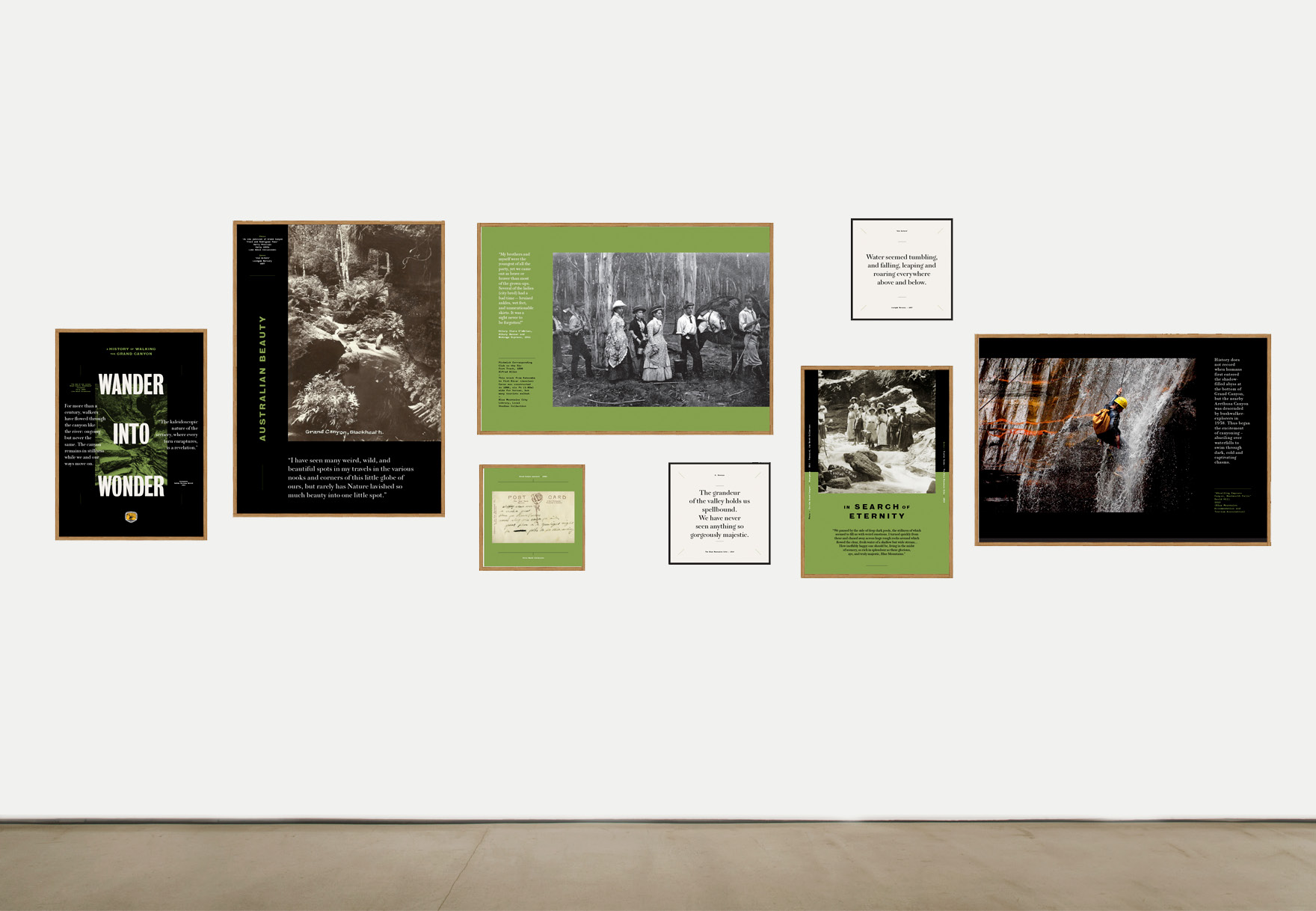Our Grand Canyon
A Walk through Blue
Mountains History
2017 — 2018

National Parks & Wildlife Service

Photo: Ona Janzen
The Grand Canyon track at Blackheath is one of the classic walks in the Blue Mountains, visited by over 90,000 people each year It was constructed during a ‘golden age’ of Blue Mountains' track building, when villages were competing for tourists by opening new attractions - making it a significant story in the history of the region.
More recently, this 100 year old track that has received a significant and decade long reconstruction. To celebrate its reopening, Heath was commissioned by the National Parks & Wildlife department to design and oversee the production of a traveling exhibition that explores the cultural significance of the track and its place in the history of the Blue Mountains. Heath wrote the title, Our Grand Canyon, and also set the tone, character, and narrative structure of this important project.

Our Grand Canyon Logo
 Our Grand Canyon Expanded Logo
Our Grand Canyon Expanded LogoWorking in partnership with esteemed local historian and photographer Ian Brown, as well as a specially assembled working group from the National Parks, Heath not only designed the exhibition, but contributed to the research, writing, naming, creative direction, conceptual planning, and production management that lead up to a successful launch in late 2016 - with plans to travel the exhibition to different venues around the country over the next several years.

Vintage map highlighting the track in context
 Design development
Design development
A Harry Phillips photo of a Grand Canyon walker
 Early roadworks opening up access to the Blue Mountains
Early roadworks opening up access to the Blue Mountains
Blue Mountains visitors and trackwalkers, 1909

Original sign unveiling the new track

A typical track news article from the early 20th century
The visual language and design of the exhibition was inspired by the track itself. One of the first things that you experience when you visit the track, as with most attractions in the Blue Mountains, is the expansive sky. This is quickly followed by the foliage: a mixture of eucalypts, ferns, and coachwoods. As you descend further into the track however, you become engulfed by darkness created by massive overhanging rocks and high tree canopies. The colours found on the track, including this deep rich black, provided the foundation of the overall look and feel. Natural, raw wood with coloured detailing was chosen as the way to frame the finished work - and Heath worked with innnovative art framers United Measures in Melbourne to achieve this.
 Colour palette, inspired the sky and endemic flora
Colour palette, inspired the sky and endemic flora
Proposal document
 Social media teasers
Social media teasers Design development featuring quote
Design development featuring quote
 Framing in development at United Measures
Framing in development at United MeasuresHeath also plotted out the content structure, as well as writing the chapter headings and panel titles. The exhibition effectively begins with some pre-history, examining the formation of the landscape. It then takes the viewer on a journey from the early days of track building, of iron pickaxes and steel nerves, to the emerging tourism industry of the Blue Mountains, to the heroic conservation efforts that have lead to the preservation of the track, eventually arriving at the present day: the track’s reconstruction and reopening.
 Our Grand Canyon — Introduction
Our Grand Canyon — Introduction Chapter One: Below the Light
Chapter One: Below the Light
Chapter Two: Dream of Stone

Chapter Three: The Cloud Voyagers
 Chapter Four: Wander into Wonder
Chapter Four: Wander into Wonder
Chapter Five: Gallery of Shadows
While Our Grand Canyon is largely about telling the historical story of the track, it is also about honouring the reconstruction and the National Parks team who have worked so hard, and for so many years, to open the track back up to the public. Ultimately it’s as much about the future as it is the past.
To recognise this, Heath commissioned local photographer and regular collaborator Ona Janzen to take a suite of images of the workers and the new track itself. These images were included in the exhibition and some of them can be viewed below.

Grand Canyon trackworkers
![]()
Section of the new Grand Canyon track

Section of the new Grand Canyon track

Section of the new Grand Canyon track

Grand Canyon trackworkers